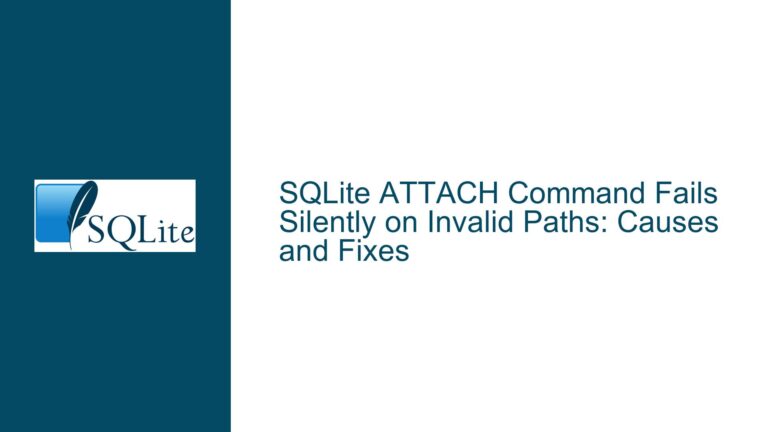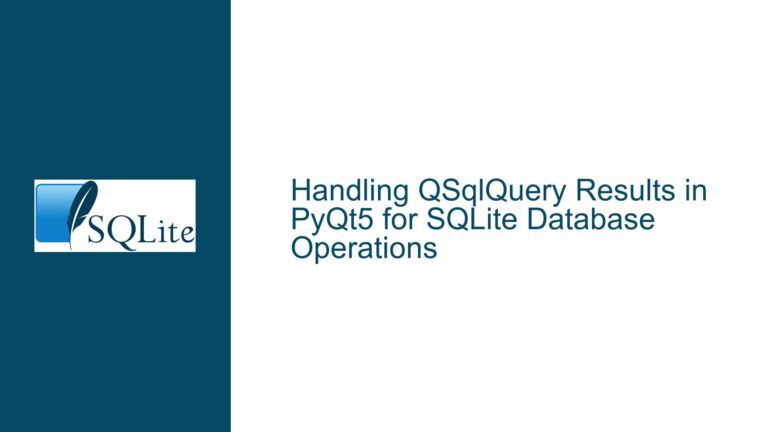Global Database Change Detection in SQLite for Cache Invalidation
Understanding the Need for a Global Data Version Counter
In the realm of database management, particularly with SQLite, the need to detect changes across the entire database for purposes such as cache invalidation is a common yet nuanced challenge. The core of the issue revolves around the desire to have a global, monotonic counter that increments with any modification to the database. This counter would serve as a straightforward mechanism to determine whether the database has changed since the last time the cache was generated, thereby signaling whether the cache needs to be refreshed.
The PRAGMA data_version in SQLite provides a version number that changes whenever a modification is made to the database by another connection. However, this pragma is connection-specific, meaning it only reflects changes made by other connections to the same database file. This limitation makes it unsuitable for scenarios where a global, connection-independent change detection mechanism is required.
Exploring the Limitations of Connection-Specific Change Detection
The primary limitation of using PRAGMA data_version for global change detection is its inherent tie to the database connection. When you execute PRAGMA data_version, it returns a value that is specific to the connection on which it is executed. This value changes only if another connection modifies the database. Consequently, if you are looking for a global indicator that reflects any change to the database, regardless of the connection, PRAGMA data_version falls short.
Moreover, the PRAGMA data_version does not provide a persistent, global counter that can be accessed independently of any active database connections. This means that if you need to check for database changes at arbitrary times, especially when no process is actively connected to the database, PRAGMA data_version cannot be relied upon. This limitation becomes particularly problematic in scenarios where the database is accessed intermittently, and you need a persistent mechanism to track changes.
Implementing a Persistent Global Data Version Counter
To address the need for a global, persistent data version counter, one approach is to implement a custom solution that leverages the existing capabilities of SQLite while overcoming the limitations of PRAGMA data_version. One such solution involves creating a dedicated thread or process that continuously monitors the database for changes using PRAGMA data_version and updates a global counter accordingly.
The implementation would involve opening a dedicated database connection in a separate thread. This thread would enter a loop where it periodically executes PRAGMA data_version and compares the returned value with the previously stored value. If a change is detected, the global counter is incremented, and the new value is stored. This global counter can then be accessed by other parts of the application to determine whether the database has changed since the last cache generation.
However, this approach assumes the presence of a persistent process that is always running and monitoring the database. In scenarios where no such persistent process exists, this solution becomes ineffective. This limitation underscores the need for a more robust mechanism that does not rely on continuous monitoring by an active process.
Leveraging SQLITE_FCNTL_DATA_VERSION for Committed Changes
An alternative approach involves using the SQLITE_FCNTL_DATA_VERSION opcode with the sqlite3_file_control() function. This opcode provides a data version number that reflects committed changes to the database. Unlike PRAGMA data_version, which is connection-specific, SQLITE_FCNTL_DATA_VERSION offers a more global perspective on database changes, as it reflects changes that have been committed to the database file.
The key advantage of SQLITE_FCNTL_DATA_VERSION is that it provides a version number that is tied to the database file itself, rather than any specific connection. This means that the version number will change whenever a committed change is made to the database, regardless of which connection made the change. This makes it a more suitable candidate for implementing a global change detection mechanism.
However, it is important to note that SQLITE_FCNTL_DATA_VERSION only reflects committed changes. This means that if a long-running transaction is in progress, changes made within that transaction will not be reflected in the data version number until the transaction is committed. This behavior can lead to situations where the cache is not invalidated promptly, potentially resulting in stale data being served.
Addressing the Challenges of Long-Running Transactions
The behavior of SQLITE_FCNTL_DATA_VERSION in the context of long-running transactions introduces a subtle but important challenge. Since the data version number only reflects committed changes, any modifications made within a long-running transaction will not be immediately visible. This delay can be problematic in scenarios where timely cache invalidation is critical.
To mitigate this issue, it is essential to design the application in such a way that long-running transactions are minimized or that the cache invalidation mechanism is aware of the potential delay. One possible strategy is to implement a two-tiered cache invalidation system. The first tier would use SQLITE_FCNTL_DATA_VERSION to detect committed changes, while the second tier would employ additional mechanisms, such as application-level flags or timestamps, to track uncommitted changes within long-running transactions.
Designing a Robust Cache Invalidation Strategy
Given the limitations and challenges associated with both PRAGMA data_version and SQLITE_FCNTL_DATA_VERSION, it is clear that a robust cache invalidation strategy requires a combination of techniques. The goal is to create a system that can reliably detect changes to the database, regardless of the connection or transaction state, and promptly invalidate the cache when necessary.
One approach is to combine the use of SQLITE_FCNTL_DATA_VERSION with application-level tracking of database changes. For example, you could maintain a global counter within the application that is incremented whenever a change is made to the database. This counter could be stored in a separate table or even in a file external to the database. When the cache is generated, the current value of this counter is stored alongside the cached data. To determine whether the cache is still valid, the application would compare the stored counter value with the current value.
This hybrid approach leverages the strengths of both SQLITE_FCNTL_DATA_VERSION and application-level tracking. The SQLITE_FCNTL_DATA_VERSION provides a reliable indicator of committed changes, while the application-level counter ensures that changes made within long-running transactions are also accounted for. By combining these techniques, you can create a cache invalidation mechanism that is both robust and responsive.
Implementing the Hybrid Cache Invalidation Mechanism
To implement the hybrid cache invalidation mechanism, you would start by creating a dedicated table within the database to store the global counter. This table would have a single row and a single column, representing the current value of the counter. Whenever a change is made to the database, the application would increment this counter as part of the transaction.
In addition to the global counter, you would use SQLITE_FCNTL_DATA_VERSION to detect committed changes. When the cache is generated, both the current value of the global counter and the data version number would be stored alongside the cached data. To check the validity of the cache, the application would compare both the stored counter value and the stored data version number with their current values.
If either the global counter or the data version number has changed since the cache was generated, the cache is considered invalid and must be refreshed. This dual-check mechanism ensures that changes made within long-running transactions are detected, even if they have not yet been committed.
Optimizing Performance and Scalability
While the hybrid cache invalidation mechanism provides a robust solution, it is important to consider the performance and scalability implications. Incrementing a global counter on every database modification can introduce additional overhead, particularly in high-throughput systems. To mitigate this, you could optimize the counter update mechanism by batching updates or using a more efficient data structure.
Additionally, the use of SQLITE_FCNTL_DATA_VERSION requires a call to sqlite3_file_control(), which may introduce some latency. To minimize this impact, you could cache the data version number and only refresh it periodically, rather than on every cache validation check. This approach reduces the number of calls to sqlite3_file_control() while still providing timely detection of committed changes.
Ensuring Consistency and Reliability
Consistency and reliability are critical aspects of any cache invalidation strategy. In the context of the hybrid mechanism, it is essential to ensure that the global counter and the data version number are always in sync with the actual state of the database. Any discrepancy between these values and the database state could lead to incorrect cache invalidation decisions.
To maintain consistency, you should ensure that the global counter is updated atomically with the database modifications. This can be achieved by including the counter update within the same transaction as the database changes. Additionally, you should implement error handling and recovery mechanisms to handle cases where the counter update fails or the database becomes inconsistent.
Conclusion: Building a Comprehensive Solution
In conclusion, detecting global changes in an SQLite database for cache invalidation requires a nuanced approach that addresses the limitations of connection-specific mechanisms like PRAGMA data_version and the challenges associated with long-running transactions. By combining the use of SQLITE_FCNTL_DATA_VERSION with application-level tracking of database changes, you can create a robust and reliable cache invalidation mechanism.
The hybrid approach outlined in this guide provides a comprehensive solution that leverages the strengths of both SQLite’s built-in capabilities and custom application logic. By carefully designing and implementing this mechanism, you can ensure that your cache remains consistent with the database state, even in complex and high-throughput environments.
Ultimately, the key to successful cache invalidation in SQLite lies in understanding the nuances of the database’s behavior and designing a solution that accounts for these nuances. With the right combination of techniques and careful attention to performance and consistency, you can build a cache invalidation strategy that meets the needs of your application while maintaining the integrity and reliability of your data.






